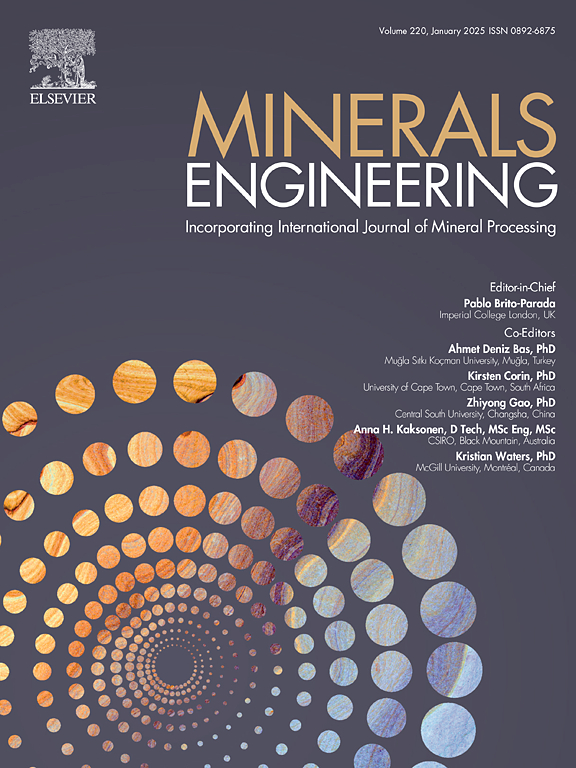Kinetics of metals dissolution from EV batteries for the development of sustainable technology
IF 4.9
2区 工程技术
Q1 ENGINEERING, CHEMICAL
引用次数: 0
Abstract
The increasing volume of scrap EV batteries generated globally poses significant challenges for disposal and recycling due to stringent environmental concerns. Recycling these batteries not only mitigates environmental pollution but also enables the recovery of valuable metals. This paper investigates the leaching kinetics of metals in the black mass of EV batteries, a crucial step in battery recycling. The black mass was separated from discarded EV batteries using chemical and mechanical pre-treatment processes. Systematic leaching studies were carried out to observe the dissolution behavior of various metals by varying parameters such as leachant concentration, reductant volume, agitation speed, pulp density, temperature, and time. Maximum dissolution (∼99.99 %) of Ni, Co, Li, Mn, and Cu were achieved using 3 % H2SO4 (v/v) and 10 % H2O2 (v/v) after 2 h at 75 °C, with a pulp density of 100 g/L and an agitation speed of 400 rpm. Leaching kinetics for Mn, Co, and Cu followed a chemical reaction control dense contant size and shrinking spheres model, (1 − (1 − X)1/3 = kct), while Li and Ni followed a chemical reaction control dense constant-size cylindrical particles model (1 − (1 − X)1/2 = kct), validated by SEM results. The activation energy for Li and Ni were 15.55 kJ/mol and 24.65 kJ/mol, respectively, while Mn, Co, and Cu had activation energyof 22.72 kJ/mol.

电动汽车电池金属溶解动力学与可持续技术发展
由于严格的环境问题,全球废旧电动汽车电池的数量不断增加,对处置和回收构成了重大挑战。回收这些电池不仅可以减轻环境污染,还可以回收有价值的金属。本文研究了电动汽车电池黑质量中金属的浸出动力学,这是电池回收的关键步骤。采用化学和机械预处理工艺从废弃电动汽车电池中分离出黑色物质。通过不同的浸出液浓度、还原剂体积、搅拌速度、矿浆密度、温度和时间等参数,进行了系统的浸出研究,观察了各种金属的溶解行为。采用3% H2SO4 (v/v)和10% H2O2 (v/v),在75°C条件下,矿浆密度为100 g/L,搅拌速度为400 rpm, 2 h后,Ni, Co, Li, Mn和Cu的最大溶解(~ 99.99%)达到。Mn、Co和Cu的浸出动力学遵循化学反应控制致密含量大小和收缩球模型(1−(1−X)1/3 = kct),而Li和Ni遵循化学反应控制致密等尺寸圆柱形颗粒模型(1−(1−X)1/2 = kct), SEM结果验证了这一点。Li和Ni的活化能分别为15.55 kJ/mol和24.65 kJ/mol, Mn、Co和Cu的活化能为22.72 kJ/mol。
本文章由计算机程序翻译,如有差异,请以英文原文为准。
求助全文
约1分钟内获得全文
求助全文
来源期刊

Minerals Engineering
工程技术-工程:化工
CiteScore
8.70
自引率
18.80%
发文量
519
审稿时长
81 days
期刊介绍:
The purpose of the journal is to provide for the rapid publication of topical papers featuring the latest developments in the allied fields of mineral processing and extractive metallurgy. Its wide ranging coverage of research and practical (operating) topics includes physical separation methods, such as comminution, flotation concentration and dewatering, chemical methods such as bio-, hydro-, and electro-metallurgy, analytical techniques, process control, simulation and instrumentation, and mineralogical aspects of processing. Environmental issues, particularly those pertaining to sustainable development, will also be strongly covered.
 求助内容:
求助内容: 应助结果提醒方式:
应助结果提醒方式:


